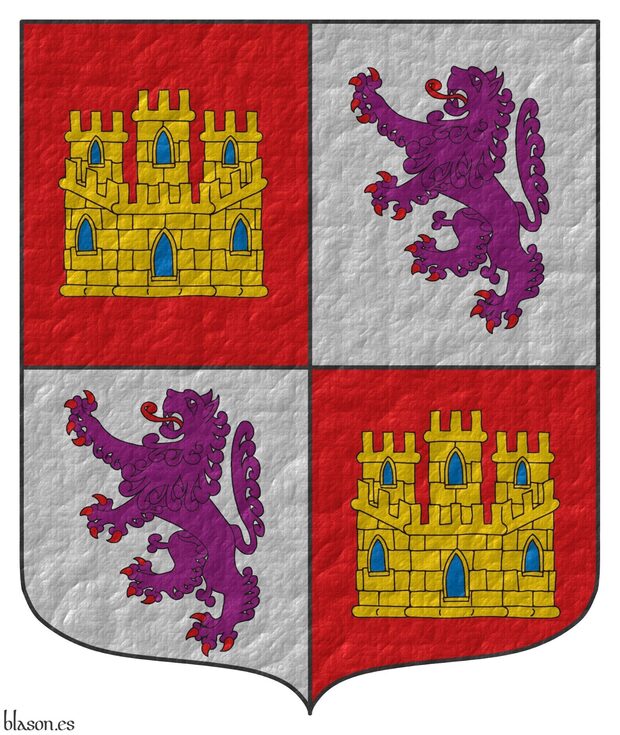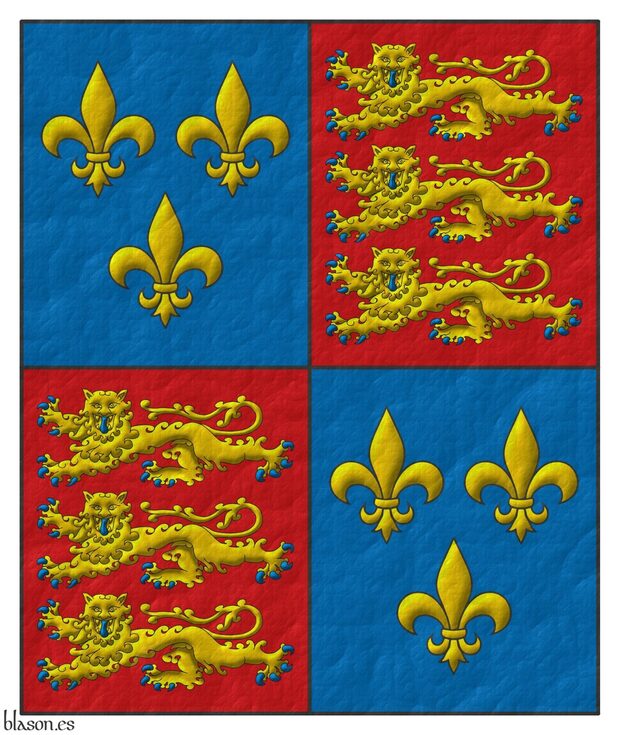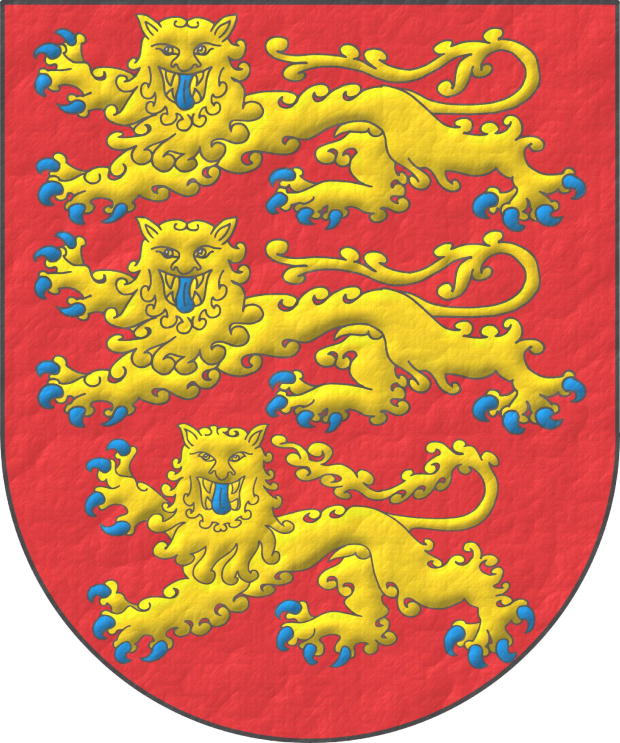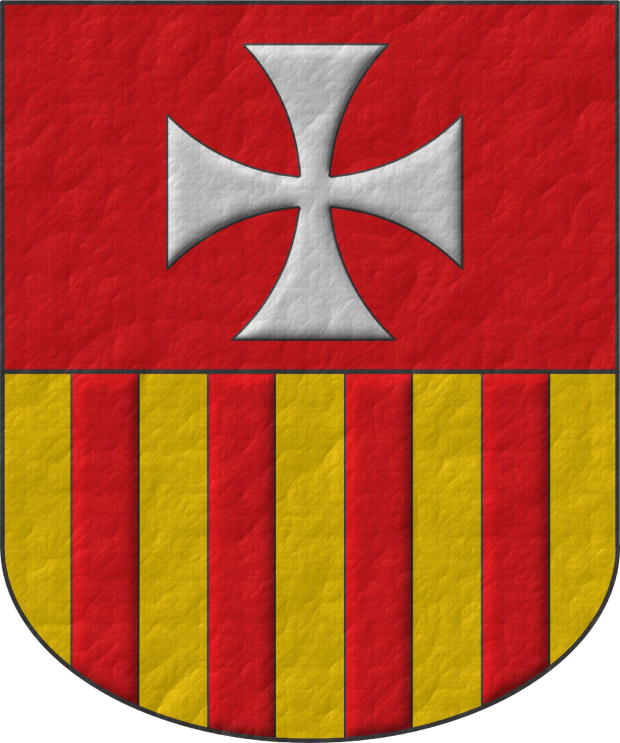Fabric

Alphonse X of Castile

Known as the Wise, King of Castile and Leon from 1252 to 1284.
Escudo cuartelado: 1o y 4o de gules, un castillo de oro, aclarado de azur, mazonado de sable; 2o y 3o de plata, un león rampante de púrpura, armado y lampasado de gules.
Quarterly: 1 and 4 Gules, a castle triple towered Or, port and windows Azure, masoned Sable; 2 and 3 Argent, a lion rampant Purpure, armed and langued Gules.
Armories of the Wise King of Castile interpreted by me with the following characteristics: the external shape of the coat of arms ends in an ogee arch; the field, the 2 castles, and the 2 lions are outlined and enameled in flat colors; and the texture seems fabric.
This coat of arms, but with a pointed external shape, can be seen in the 2nd part of the so-called armorial [Wijnbergen; 1265; cuat of arms number 1,289], with the title «Le roy Despaingne», which in this context is understood to refer to Castilla y León.
The 2nd part of this armorial was made between 1270 and 1285 and, being Alphonse X king of Castile and Leon from 1252 to 1284, it is to Him that the title «Le roy Despaingne» seems to refer.
Blazon keywords: Quarterly, Gules, Or, Azure, Sable, One, Castle, Port and windows, Masoned, Argent, Purpure, Lion, Rampant, Armed and Langued.
Style keywords: Ogee, Plain tincture, Outlined in sable and Fabric.
Classification: Interpreted, Personal, Coat of arms and Kingdom of Castile and Leon.
Bearer: Alphonse X of Castile.


Cáceres, Province of

Party per pale: 1 Gules, a castle triple towered Or, port and windows Azure, masoned Sable; 2 Argent, a lion rampant Purpure, armed and langued Gules, crowned Or.
Escudo partido: 1o de gules, un castillo de oro, aclarado de azur, mazonado de sable; 2o de plata, un león rampante de púrpura, armado y lampasado de gules, coronado de oro.
Civic coat of arms interpreted by me as follows: the shield has a semicircular (round) base; the field, the castle and the lion are illuminated; the lion and its crown are outlined in the colour of the field; the open royal crown and the castle are outlined in Sable, in the case of the castle because it is masoned; and the whole has a canvas texture.
Blazon keywords: Party per pale, Argent, Purpure, Gules, Or, Azure, Castle, Lion, Port and windows, Masoned, Rampant, Armed, Langued, Crowned, Crown and Open royal crown.
Style keywords: Semi-circular, Illuminated and Fabric.
Classification: Interpreted, Civic, Coat of arms and Kingdom of Castile and Leon.
Bearer: Cáceres, Province of.


Edward IV of England

Banner Quarterly: 1 and 4 Azure, three fleurs de lis Or; 2 and 3 Gules, three lions, passant, guardant, in pale Or, armed and langued Azure.
Pendón cuartelado: 1o y 4o de azur, tres flores de lis de oro; 2o y 3o de gules, tres leopardos en palo de oro, armados y lampasados de azur.
Banner interpreted by me as follows: with the proportions of 5x6, like a shield; the field is coloured in flat tinctures Gules and Azure; the fleurs-de-lis and the leopards are outlined in Sable and illuminated in Or; and the banner’s finish resembles fabric.
Its design follows [Edward IV of England; 1461; row 27, 2nd column, final banner]:
- which represents what are considered «the royal arms of England»,
- which were also borne by Henry V of England,
- which Henry VI of England placed in the 2nd quarter of a per pale shield, where he set those of France in the 1st, and
- which were restored by Henry IV, as shown here.
Blazon keywords: Quarterly, Azure, Or, Three, Fleur de lis, Ordered, Gules, Leopard, Armed, Langued and In pale.
Style keywords: Rectangular, Illuminated, Outlined in sable and Fabric.
Classification: Interpreted, Personal, Flag, Banner of arms, Kingdom of England and House of York.
Bearer: Edward IV of England.


Edward Longshanks

King of England and Lord of Ireland from 1272 to 1307.
Gules, three lions, passant, guardant, in pale Or, armed and langued Azure.
Escudo de gules, tres leopardos en palo de oro, armados y lampasados de azur.
Coat of arms interpreted with the following features: the mouth is semicircular (round); the field enamelled in a flat tint of Gules; the three leopards illuminated in the metal Or and the colour Azure, outlined in Sable, and the leopard closest to the base has a different shape and size; and the whole finished with a fabric-like texture.
Blazon keywords: Without divisions, Gules, Or, Azure, Three, Leopard, Armed, Langued and In pale.
Style keywords: Semi-circular, Illuminated, Outlined in sable and Fabric.
Classification: Interpreted, Personal, Coat of arms, House of Plantagenet and Kingdom of England.
Bearer: Edward I of England.


King Arthur, banner with cross flory

Banner Vert, a cross flory Argent.
Pendón de sinople, una cruz flordelisada de plata.
Imaginary banner interpreted in the following way: the banner has a 5x6 proportion; the field has been enameled with flat color Vert; the cross flory is illuminated Argent and outlined in Sable; and the finish is cloth-like.
This banner appears in [Edward IV of England; 1461; row 15, 1st column].
Blazon keywords: Without divisions, Vert, Argent, Cross flory and Cross couped.
Style keywords: Rectangular, Illuminated, Outlined in sable and Fabric.
Classification: Interpreted, Imaginary, Flag, Banner of arms and Kingdom of England.
Imaginary bearer: Arthur of Britain.


Norman Darcy

Norman de Darcy ~ Norman Darcy ~ Norman de Arci.
Argent, three cinquefoils Gules.
Escudo de plata, tres quinquefolios de gules.
Included in [Vincent, MS; 1285; number 230] also known as [St. George's Roll; 1285; number 230].
Blazon keywords: Without divisions, Argent, Three, Cinquefoil, Gules and Ordered.
Style keywords: Triangular curved, Illuminated, Shaded, Outlined in sable and Fabric.
Classification: Interpreted and Personal.
Bearer: Norman de Darcy.


Order of Mercy, rounded and cloth-like

Party per fess: 1 Gules, a cross patty Argent; 2 Or, four pallets Gules.
Escudo cortado: 1o de gules, una cruz patada de plata; 2o de oro, cuatro palos de gules.
These already existing arms have been interpreted with: the mouth of the coat of arms rounded; its field has received an enamel of flat tincture style, of Gules color and Or metal; its cross patty and its 4 pales are illuminated; and the whole coat of arms has received a cloth-like finish.
The party per fess coat of arms of the Royal and Military Order of Our Lady of Mercy and the Redemption of Captives is the fusion of 2 gifts: the cross patty that was donated to the Order by Bishop Berenguer de Palou on the day of its foundation and the coat of arms of Aragon that King James I of Aragon, the Conqueror, also present at the ceremony, on August 10, 1218, gave to the Order as a symbol of support for the redemptive work of Peter Nolasco.
Blazon keywords: Party per fess, Gules, Or, Argent, Cross, One, Cross patty, Cross couped and Pale.
Style keywords: Rounded, Illuminated, Outlined in sable and Fabric.
Classification: Interpreted, Religious and Coat of arms.
Bearer: Our Lady of Mercy, Order of.
-
Language
-
Categories of heraldry
-
Divisions of the field
- Without divisions
- Party per pale
- Party per fess
- Party per bend
- Party per bend sinister
- Tierce
- Tierce sinister
- Tierced per pale
- Tierced per fess
- Tierced per bend
- Tierced pallwise inverted
- Quarterly
- Quarterly per saltire
- Gyronny
- Party per fess, the chief per pale
- Party per pale, the sinister per fess
- Party per fess, the base per pale
- Party per pale, the dexter per fess
- Chapé
- Chaussé
- Embrassé
- Contre-embrassé
- Party per chevron
- Enté
- Enté en point
- Flanched
-
Metals
-
Colours
-
Furs
-
Other tinctures
-
Ordinaries and sub-ordinaries
-
Diminutives of the ordinaries
-
Geometric charges
-
Composite ordinaries
-
Inanimate charges from Nature
Atom, Crescent, Diamond, Emerald, Estoile, Increscent, Lightning flash, Moon, Mount, Mullet, Mullet of four points, Orbital, Plough of Ursa Major, Rainbow, Ray of the sun, River, Sea, Snowflake, Sun, Sun in splendour, Sun of May, Trimount and Water.
-
Vegetal charges from Nature
Acorn, Apple, Apple tree, Ash, Bluebonnet, Camellia, Chrysanthemum, Cinquefoil, Cornflower, Dogwood flower, Double rose, Elm, Fleur de lis, Flower, Gourd, Holm oak, Hop cone, Kapok tree, Laurel, Lily, Linden, Lotus flower, Madonna lily, Oak, Olive tree, Palm tree, Pomegranate, Poplar leaf, Rose, Shamrock, Sunflower, Thistle, Tree, Tulip, Vine and Wheat.
-
Animal charges from Nature
Badger, Bald eagle, Barbel, Barn owl, Bear, Beaver, Beetle, Bighorn sheep, Blackbird, Boar, Brach hound, Bull, Doe, Dog, Dolphin, Dove, Eagle, Elephant, Falcon, Fish, Flame, Fly, Fox, Frog, Goat, Goldfinch, Goose, Heron, Horse, Hummingbird, Jaguar, Lark, Leopard, Lion, Lion passant, Lion rampant guardant, Lioness, Lynx, Male figure, Martlet, Merino ram, Owl, Panther, Parrot, Peacock, Pelican, Pelican in her piety, Puffin, Quetzal, Raven, Roe deer, Rooster, Savage, Seagull, Serpent, She-wolf, Stag, Starling, Talbot, Tyger, Vulture, Warren hound and Wolf.
-
Parts of natural charges
Arm, Beak, Branch, Caboshed, Chest, Claw, Covert, Dorsal fin, Eagle claw, Ermine spot, Escallop, Feather, Foot (palmiped), Foreleg, Forepaw, Hand, Head, Heart, Hoof, Leaf, Neck, Ostrich feather, Palm frond, Paw, Roe deers' attires, Shoulder, Sprig, Stags' attires, Stem, Swallow-tail, Tail, Tail addorsed, Tail fin, Talon, Tooth, Trunk, Trunk (elephant), Two hands clasped, Two wings in vol, Udder, Wheat spike, Wing and Wrist.
-
Artificial charges
Ace of spades, Anchor, Anvil, Arch, Arm vambraced, Armillary sphere, Arrow, Axe, Bell, Bell tower, Beret, Bonfire, Book, Bookmark, Bow, Bridge, Broken, Buckle, Cannon, Cannon dismounted, Cannon port, Canopy roof, Carbuncle, Castle, Celtic Trinity knot, Chain, Chess rooks, Church, Clarion, Clay pot, Closed book, Club, Comb, Compass rose, Conductor's baton, Cord, Covered cup, Crozier, Crucible, Cuffed, Cup, Cyclamor, Dagger, Double vajra, Drum, Ecclesiastical cap, Fanon, Federschwert, Fleam, Four crescents joined millsailwise, Galician granary, Garb, Gauntlet, Geometric solid, Grenade, Halberd, Hammer, Harp, Host, Hourglass, Key, Key ward, Knight, Knot, Lantern, Letter, Line, Loincloth, Menorah, Millrind, Millstone, Millwheel, Monstrance, Mortar, Mullet of six points pierced, Nail, Non-classic artifact, Norman ship, Number, Oar, Oil lamp, Open book, Page, Pair of scales, Parchment, Pestle, Piano, Pilgrim's staff, Plough share, Polish winged hussar, Port, Portcullis, Potent, Quill, Ribbon, Rosette of acanthus leaves, Sabre, Sackbut, Sail, Scroll, Scythe, Sheaf of tobacco, Ship, Skirt, Spear, Spear's head, Stairway, Star of David, Step, Sword, Symbol, Tetrahedron, Torch, Tower, Trident, Trumpet, Turret, Two-handed sword, Wagon-wheel, Water-bouget, Wheel, Winnowing fan and With a turret.
-
Immaterial charges
Angel, Archangel, Basilisk, Dragon, Dragon's head, Garuda, Golden fleece, Griffin, Heart enflamed, Mermaid, Our Lady of Mercy, Ouroboros, Paschal lamb, Pegasus, Phoenix, Sacred Heart of Jesus, Saint George, Sea-griffin, Trinity, Triton, Unicorn, Winged hand and Wyvern.
-
External elements
-
Heraldic creations
-
References
-
Formats
-
Keywords on this page
Port and windows, Alphonse X of Castile, Armed, Arthur of Britain, Azure, Flag, House of Plantagenet, House of York, Castle, Ogee, Crown, Open royal crown, Crowned, Party per fess, Cross, Cross flory, Cross patty, Cross couped, Quarterly, Cáceres, Province of, Outlined in sable, Edward I of England, Edward IV of England, In pale, Fabric, Coat of arms, Fleur de lis, Personal, Gules, Illuminated, Imaginary, Interpreted, Langued, Leopard, Lion, Masoned, Semi-circular, Ordered, Or, Banner of arms, Argent, Without divisions, Purpure, Rampant, Rectangular, Kingdom of Castile and Leon, Kingdom of England, Three and One.
